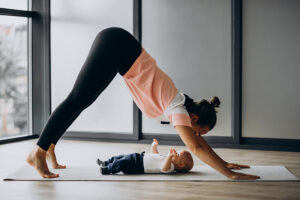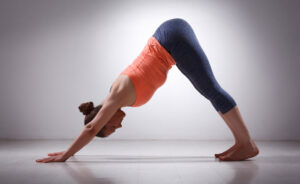Yoga is often portrayed as a solitary practice – just you flowing through poses on your mat. But invite your significant other to share the mat, and yoga transforms into a tool for fostering intimacy between couples.
Partner yoga refers to performing yoga postures in physical contact with another person, focusing on shared movement and breath. This harmonious connection has profound effects on relationships.
Research published in the Journal of Sex & Marital Therapy shows participating in partner yoga for just 8 weeks increases relationship satisfaction across factors like intimacy, trust, passion and communication. Over 80% of couples in the study reported feeling “more emotionally connected and in-tune” with their partner after couple yoga sessions.
4 scientific proofs that practicing couple yoga postures cultivates closeness
Increases Oxytocin
Sustained gentle touch triggers the release of oxytocin, the bonding hormone associated with emotional attachment. Partner yoga involves continuous physical contact, boosting oxytocin.
Enhances Empathy
Moving in cohesion requires being acutely aware of your partner’s needs and limitations – the foundation of empathy. As empathy grows, self-centeredness reduces making space for intimacy.
Deepens Vulnerability
Holding each other in balance during tricky poses makes you feel safe expressing yourself emotionally off the mat too. Lowering defensive walls is key for true intimacy.
Improves Non-Verbal Cues
Following subtle body language to move in sync enhances non-verbal sensitivity. You become more perceptive to your partner’s unspoken messages and needs.
As Elise Browning Miller notes in her book Yoga for Partners, “the intuition, playfulness and sensitivity cultivated in duo practice lays the groundwork for heart-centered relationships.”
Up next, we cover easy starter poses for couples looking to begin a partner yoga journey.
Looking to take up partner yoga with your significant other but don’t know where to begin? It’s wise to start with foundations before attempting fancy acrobatics.
These 8 beginner couple yoga poses establish connection while being gentle on the body – perfect for two people starting their joint yoga practice.
Practice them 3-4 times per week after warming up, flowing smoothly between poses within your comfort zone.
1. Seated Heart Connection
Sit facing each other with knees bent, feet lifted and your thighs touching. Close eyes, hold hands and breathe in unison to feel each other’s energy flow.

2. Back-to-Back Seated Twist
Sit back-to-back with legs crossed. Exhale and use your partner’s counter pressure to gently twist deeper. Releases spinal tension while relying on each other.

3. Bound Eagle Pose
Stand side-by-side, wrap one arm under your partner’s and link hands upon inhalation. Exhale, cross outer legs and sit deeper for balance. Teaches trusting support.

4. Forward Fold Assist
Stand behind your bent over partner. Clasp their hands gently and guide them into a comfortable forward stretch for several breaths. Builds care and understanding.

5. Squat Chest Opener
Face each other a couple feet apart in a wide squat. Press palms together and pulse up and down slightly in the squat, engaging your legs as you stretch chests open. Boosts mobility.

6. Side Plank With Leg Lift
Get into a right side plank while your partner mirrors you. On an exhale, raise your top leg and connect with your partner’s hand for stability. Repeat on the other side. Strengthens focus.

Conclusion:
Practice these foundations until you can move as one unit before progressing to more challenging couple poses requiring balance and postural precision.
Making the Most of Your Partner Yoga Practice
Ready to begin a journey of intimacy and connection with your significant other through couple yoga? Here are 5 tips to set you up for success:
1. Discuss Expectations Openly
Before your first session, talk honestly about what each of you hopes to achieve via partner yoga. Align your intentions.
2. Take It Slowly
Never force poses to the point of strain. Move steadily into stretches using breaths. Stop if anyone feels discomfort.
3. Prioritize Non-Verbal Cues
Pay more attention to your partner’s body language than verbal instructions. Let go of judgements if poses aren’t perfectly executed.
4. Maintain Loving Touch
Keep physical contact respectful throughout. Any hands-on adjustments should nurture, not restrict.
5. End With Gratitude Ritual
After each practice, thank your partner for their time and for letting you support them. Celebrate baby steps!
The key is treating your partner with dignity throughout this intimate experience. Let go of ego and perfectionism – it’s not about the shapes but about your shared spiritual journey.
When practiced with care and awareness, couple yoga builds the bedrock for secure-functioning relationships via vulnerability, trust and attunement.
Commonly Asked Questions for Couple Yoga Poses
What are the benefits of doing yoga poses with a partner?
Beyond making yoga more engaging, FlexifyMe highlights how partner yoga builds connection and intimacy by practicing vulnerability through giving and receiving assistance, having to synchronize physically and verbally throughout flows. Studies show it can lower stress and anxiety better together by elevating mood via poses that stimulate circulation while incorporating bonding oxytocin-boosting touch. Our experts describe this makes it ideal for couples.
What are some yoga poses for two people that focus on improving flexibility?
Poses like "Reclined Straddle with Strap Assist", "Partner Shoelace Pose” and “Seated Forward Fold with Support” let your partner provide gentle added traction that allows you to go deeper into stretches through resistance over time, opening tight areas like hips, hamstrings and shoulders. Cody's instructors recommend this gives "proprioceptive feedback about alignment" in folded postures as well, improving body awareness in splits and binds.
Are there any yoga poses for couple that are specifically beneficial for pregnant women?
FlexifyMe recommends prenatal poses like "Supported Squat", "Double Tree" and "Back-to-Back Standing Pose" which provide stability and take pressure off the lower back as pregnant women experience shifting weight and joints loosening from relaxin hormone changes. Our experts advise these can be done safely throughout all trimesters to gently open hips and build strength for comfortable stability during delivery and postpartum.
How can I modify easy yoga poses for two people to make them more challenging?
Yoga Journal suggests trying balancing on each other in poses like "Side Plank With Foot Assist", using resistance bands for extra oppositional pull in seated twists, and transitioning basic assists like "Child's Pose" into more inversion prep like "Downward Facing Dog On Partner's Feet". Coordinate modifications gradually and communicate comfort levels frequently.
What are some yoga poses for two people that focus on building strength?
Poses leveraging body weight like "Rowing Boat", partner resistance in moves like "Plank With Leg Lift Assist", and balance challenges such as "Side-By-Side Tree" all build functional strength safely together over time by distributing effort across four limbs with alignment guidance from your partner. Cody recommends these for amplifying strength training results.
What are some intermediate yoga poses for two people that are good for building on beginner poses?
Great intermediate partner yoga poses feature more balance and coordination, building from basics like "Legs Up The Wall" into prep poses for inversions like "Side-By-Side Downward Facing Dog". Others include syncing up for timing challenges in "Dancer Pose With Support" and learning to stabilize together in lifts like "Bird of Paradise".
Are there any yoga poses for two people that can help with stress relief and relaxation?
Soothing poses done together like "Partner Savasana" and gentle assisted stretches in "Reclining Hand-to-Big Toe Pose" promote relaxation as partners time breath, ease muscle tension and regulate their nervous system in unity. Joint release moves like "Seated Backbend Assist" also offer connection during passive opening, ideal for de-stressing through that drug-free high of yoga.
What are some yoga poses for two people that focus on improving balance?
Poses leveraging close contact synchronization to develop balance together include "AcroYoga Squat", teaching how to stack weight smoothly, inversions like "Partner Headstand" learning to ground as a stable base, and creative challenges like "Eagle Pose" requiring heightened concentration between partners over time.


